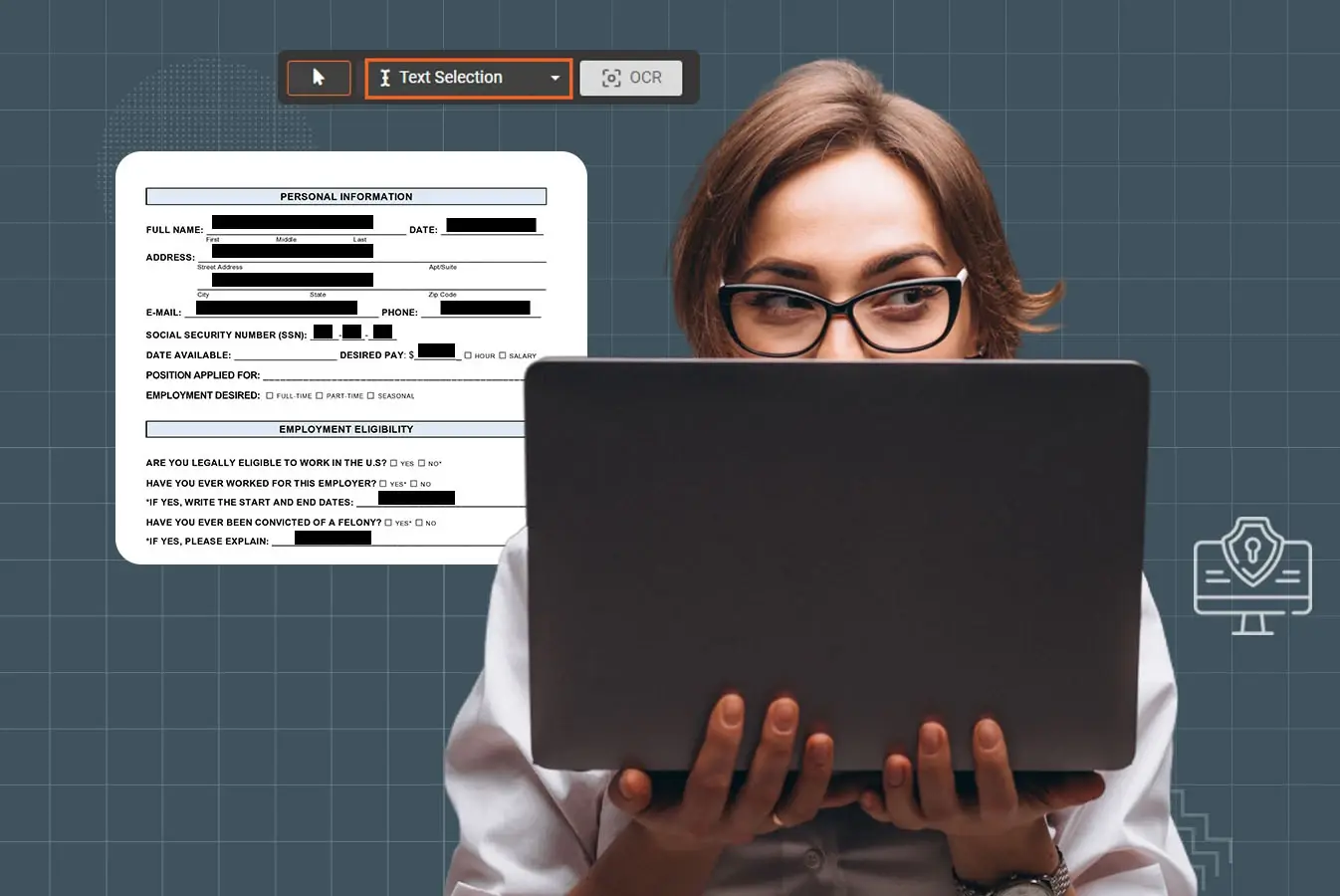Personally Identifiable Information includes any data that helps narrow down one's identity, such as social security number, email address, full name, biometrics, and so on.
This info distinguishes individuals from one another directly or when paired with other data. For instance, people can be singled out when their heritage, gender, name, and D.O.B. are available.
To make matters worse, our increased personal and professional reliance on information technology has escalated the flow of PII, putting a target on our backs.
You see, in the wrong hands, this sensitive data can be used to drain bank accounts, transact debit or credit cards, claim tax refunds, steal identities, etc.
According to the Federal Bureau of Investigation, over 100,000 personal data and identity theft breaches occur yearly. To make matters worse, 87% of people fail to protect personal information, leaving it readily available for prying eyes.
So it's not surprising that Deloitte's study revealed that 71% of businesses look forward to adhering to better data protection regulation protocols to safeguard Personally identifiable information.
This is why regional and cross-border regulations are in place to ensure PII remains protected. And PII violations lead to fines ranging from a slap on the wrist to hefty amounts.
In this blog, we'll explore what Personally identifiable information is and how PII redaction software helps keep your info safe, especially when it comes to avoiding data breaches.
What is Personally Identifiable Information (PII)?
PII, or Personally Identifiable Information, is any data that can be used to identify a specific individual. Examples of PII include but are not limited to driver's license numbers, social security numbers, addresses, full names, etc.
PII isn't limited to apparent identifiers like the ones above; it also extends to data fragments that could reveal an individual's identity when combined with other datasets.
What are the types of Personally Identifiable Information (PII)?
Personally Identifiable Information falls into two categories: Sensitive PII and Non-Sensitive PII.
Sensitive PII consists of personal data that, if leaked or stolen, could significantly harm an individual. It is not publicly available and is subject to strict data protection regulations.
Social Security number (SSN), among other identifiers like driver's license numbers, passport numbers, and government-issued I.D. numbers, is an excellent example of sensitive data.
Non-sensitive PII refers to personal data that, when leaked or stolen in isolation, is less likely to harm an individual. It may or may not be unique to a person and is often made public.
For example, a social media handle would be a non-sensitive PII. It could identify someone, but a malicious actor couldn't commit identity theft armed with only a social media account name. Other examples of non-sensitive PII include zip code, race, gender, etc.
It's important to note that the classification of PII as sensitive or non-sensitive can depend on context.
Data sensitivity may change based on how information is used, combined, or disclosed. A full name may be non-sensitive, but a list of people who have visited a particular doctor would be sensitive.
Similarly, a person's phone number may be publicly available, but a database of phone numbers used for two-factor authentication on a social media site would be sensitive PII.
And if you are wondering, "Is all personal data considered PII?" No, it is not; for instance, someone's Netflix usage is not considered PII because identifying an individual based on this data is hard, if not impossible.
What do privacy laws say about PII?
According to McKinsey, 75 percent of countries have implemented data privacy laws governing PII collection, retention, and use.
In the United States, organizations follow guidelines from the National Institute of Standards and Technology (NIST) to protect Personally identifiable information.
Here, PII means any information that can be used to determine who someone is, including names, social security numbers, birth dates, and even unique physical characteristics. It also covers any data that, when combined with other information, can identify a person, like health records or financial details.
In the European Union, a directive called 95/46/E.C. defines personal data as any information that can tell you who a person is. This includes I.D. numbers or details about a person's physical, mental, or social identity.
In Australia, the Privacy Act of 1988 sets out rules for handling PII, giving people the right to know why their information is being collected and who will have access to it.
This law is based on the Information Privacy Principles (I.P.P.s), which guide how the government and businesses can collect and use PII in Australia.
What is PII redaction?
PII redaction refers to concealing sensitive information that, if revealed, could be used to identify an individual or entity. Usually, this is achieved by blurring, pixelating, or placing a black box on the sensitive data to protect its integrity.
PII redaction is essential to securing information by detecting and hiding it in documents, videos, and audio.
Why is PII Redaction Important?
The need for PII redaction has taken center stage due to the exponential growth of personal data collection and storage facilitated by digital technology.
Now, more than ever, people are conscious of data privacy and insist on responsible and secure handling of their personal information.
Therefore, safeguarding personal data from unauthorized access, misuse, and disclosure has become necessary.
In a nutshell, PII redaction is vital because:
- Privacy and Security: Redacting PII safeguards individuals' Privacy by preventing disclosure of their personal data. This is particularly important in legal proceedings where sensitive details may become public records.
- Compliance requirements: Laws such as the California Consumer Privacy Act (CCPA), Health Insurance Portability and Accountability Act (HIPAA), General Data Protection Regulation (GDPR), and Freedom of Information Act (FOIA) have resulted in an increased focus on ensuring the integrity of personal data.
Read more about the risks of PII exposures on the VIDIZMO blog: Hidden Risks of Ignoring Redaction: Why is it Important?
How to Perform PII redaction?
Personally identifiable information can be redacted manually or use an AI-backed PII software for automatic redaction.
Manual redaction
Here are some key aspects of manual PII redaction:
- Human Oversight: Manual redaction relies on human judgment and expertise. Trained personnel review documents or data to identify and redact PII, such as social security numbers, addresses, and names.
- Accuracy and Precision: Human reviewers can exercise discretion in identifying and redacting only the necessary information, ensuring that legitimate data remains intact.
- Control: Manual redaction offers a high level of control, making it suitable for handling complex documents or unique cases where automated tools might struggle.
- Time-Consuming: This method can be time-consuming, especially for large datasets or extensive documents, and may not be scalable for organizations with substantial PII redaction needs.
Automatic Redaction
A.I. detects faces, objects, PII information, and other elements present in a video or audio file and conceals it.
Here are the key features of automatic PII redaction:
- Speed and Scalability: Automatic redaction tools can quickly process vast amounts of data, making them ideal for organizations with high-volume PII redaction needs.
- Consistency: Automation ensures consistent redaction, reducing the risk of human error or oversight.
- Pattern Recognition: These tools use pattern recognition and machine learning to identify PII, consistently finding and redacting information.
Read more about Automatic Redaction or Manual Redaction – Which One's Better?
Best tool for PII redaction: VIDIZMO Redactor
Want a combination of both Manual and Automatic redaction? VIDIZMO Redactor is the right choice for you.
It is an AI-backed PII redaction software that allows autonomous and manual redaction to ensure that no personally identifiable information is left behind.
If a media file includes transcribed content, the system will automatically detect and redact PII information within the media playback as well as within its associated transcription file when uploaded to the VIDIZMO redactor portal.
Besides that, the VIDIZMO Redactor extends its capabilities to bulk document redaction — PII can be detected and redacted within a bunch of files within clicks.
And that is just the tip of the iceberg; there are several features and bells and whistles to make your life easy.
Try it Out for Free!
Personally identifiable information (PII) redaction is crucial to data protection and Privacy. Whether you're an individual safeguarding your personal information or an organization handling sensitive data, understanding and implementing effective PII redaction practices is essential.
Remember, in the digital age, safeguarding PII is not just a choice but a responsibility we all share.
FAQs
What happens when PII is leaked?
The leakage of Personally Identifiable Information (PII) opens doors for malicious actors to capitalize on security vulnerabilities within logistics API implementation and consumers' online purchasing patterns.
Is PII a first and last name?
The first name is not PII because it's likely that many people have the same name. However, a full name — first, middle, and last — is considered PII.
What are the risks of PII?
The risks of PII include identity theft, data breaches, harm to one's reputation, and the imposition of regulatory fines.
How many different types of personal information are there?
There are two main types of personal information: Sensitive Personally Identifiable Information (S.P.I.) and Non-sensitive Personally Identifiable. The former can lead to one's identity on a standalone basis, whereas the latter narrows down to an identity when paired with other information.
What is P.I. in GDPR?
Personal information in the context of GDPR refers to photographs, social media posts, preferences, phone numbers, addresses, names, etc.—basically any information that can lead to one's identity.
Posted by VIDIZMO Team
We at VIDIZMO are experts in secure and compliant video streaming and digital evidence management. Our aim is to help educate such that you can better utilize your video data.
- Tags
- Redaction







